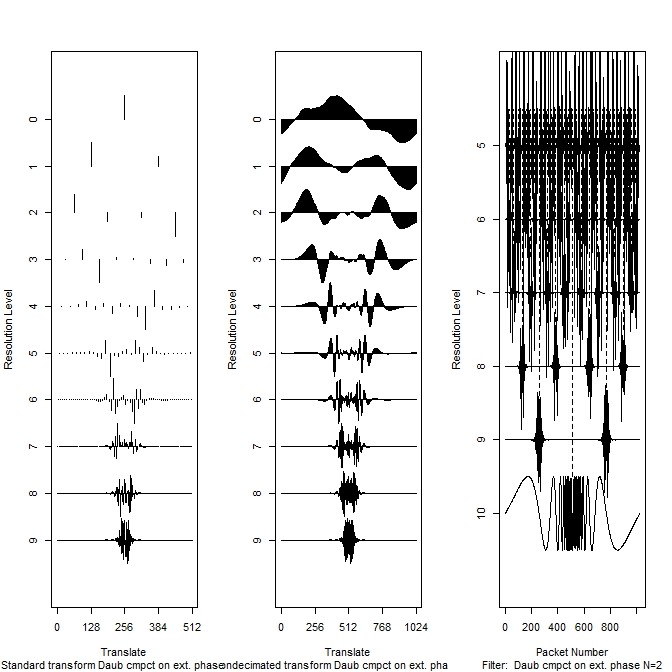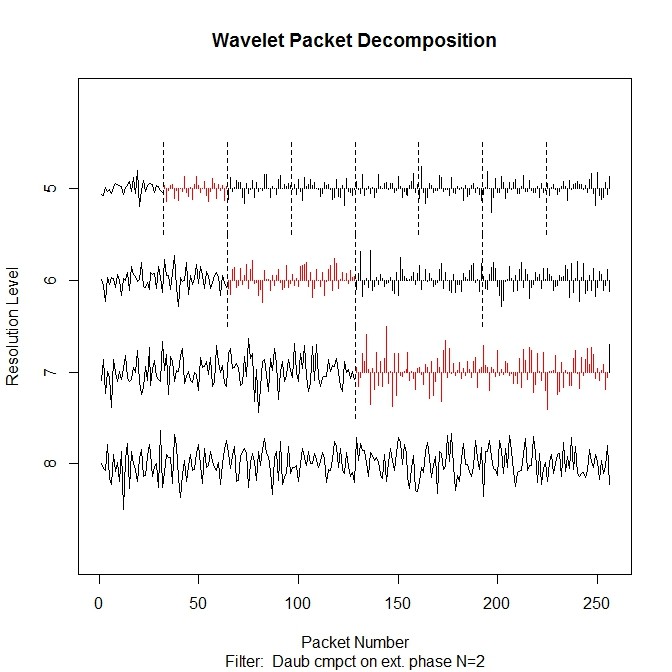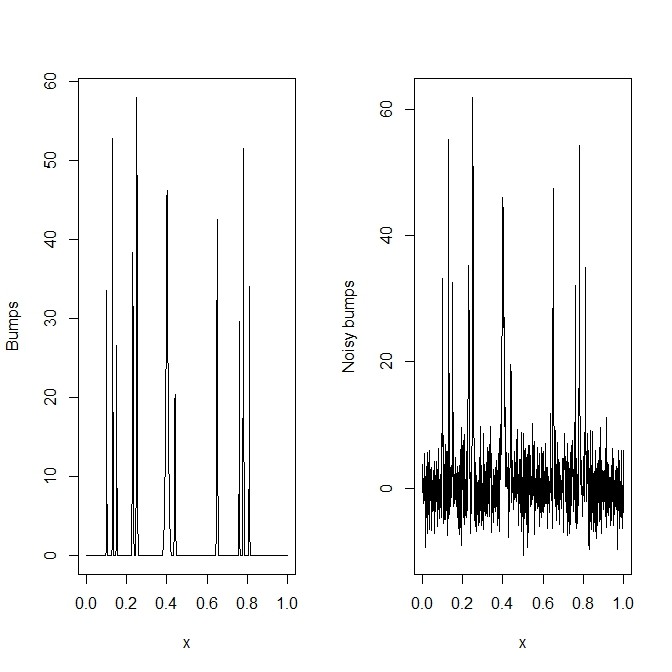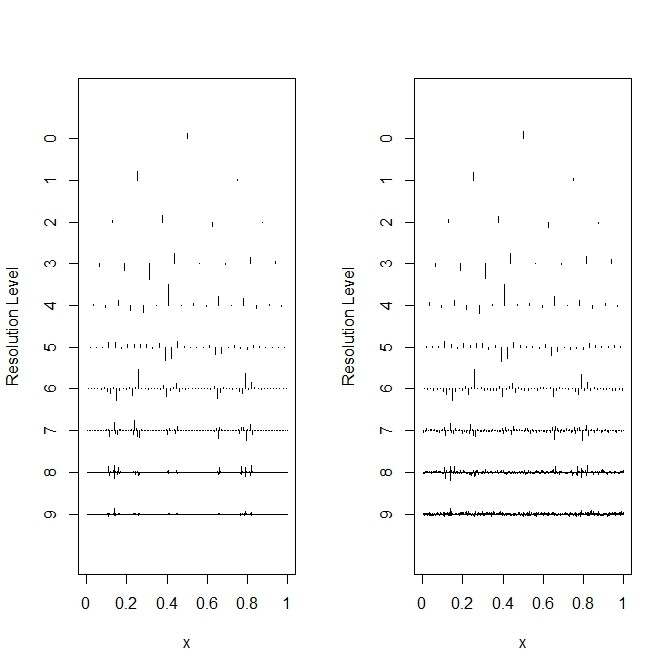ウェーブレット変換〜WaveThreshパッケージを使ってみる

Wavelet Methods in Statistics with R (Use R!)
- 作者: Guy Nason
- 出版社/メーカー: Springer
- 発売日: 2008/08/11
- メディア: ペーパーバック
- クリック: 2回
- この商品を含むブログを見る
- 離散ウェーブレット。シグナルベクトルの長さは2のべき乗
library("WaveThresh") y <- c(1,1,7,9,2,8,8,6) # filter.numberとfamilyでHaarフィルタを指定している ywd <- wd(y,filter.number=1,family="DaubExPhase") name(ywd) # フィルタとして使ったベクトル ywd$filter # 変換後 accessD(ywd,level=2) # 2^kの長さのシグナルのとき、0,1,2,...,k段階のフィルタリングの結果が出る plot(ywd) ywd
- 段階ごとのフィルタベクトルを行列形で作って示す
W1 <-t(GenW(filter.number=1, family="DaubExPhase")) W1
> ywd$filter $H [1] 0.7071068 0.7071068 $G NULL $name [1] "Haar wavelet" $family [1] "DaubExPhase" $filter.number [1] 1 > accessD(ywd,level=2) [1] 9.182828 -4.021581 -11.502039 -2.611543 > ywd Class 'wd' : Discrete Wavelet Transform Object: ~~ : List with 8 components with names C D nlevels fl.dbase filter type bc date $C and $D are LONG coefficient vectors Created on : Thu Dec 12 09:50:29 2013 Type of decomposition: wavelet summary(.): ---------- Levels: 10 Length of original: 1024 Filter was: Haar wavelet Boundary handling: periodic Transform type: wavelet Date: Thu Dec 12 09:50:29 2013
> W1 [,1] [,2] [,3] [,4] [,5] [,6] [1,] 0.3535534 0.3535534 0.3535534 0.3535534 0.3535534 0.3535534 [2,] 0.7071068 -0.7071068 0.0000000 0.0000000 0.0000000 0.0000000 [3,] 0.0000000 0.0000000 0.7071068 -0.7071068 0.0000000 0.0000000 [4,] 0.0000000 0.0000000 0.0000000 0.0000000 0.7071068 -0.7071068 [5,] 0.0000000 0.0000000 0.0000000 0.0000000 0.0000000 0.0000000 [6,] 0.5000000 0.5000000 -0.5000000 -0.5000000 0.0000000 0.0000000 [7,] 0.0000000 0.0000000 0.0000000 0.0000000 0.5000000 0.5000000 [8,] 0.3535534 0.3535534 0.3535534 0.3535534 -0.3535534 -0.3535534 [,7] [,8] [1,] 0.3535534 0.3535534 [2,] 0.0000000 0.0000000 [3,] 0.0000000 0.0000000 [4,] 0.0000000 0.0000000 [5,] 0.7071068 -0.7071068 [6,] 0.0000000 0.0000000 [7,] -0.5000000 -0.5000000 [8,] -0.3535534 -0.3535534
- フィルタがorthogonalであるとは、転置行列を掛けて単位行列ができること
W1 %*% t (W1)
- 別のfamilyで作ったフィルタでも同じ
W1 <-t(GenW(filter.number=10, family="DaubLeAsymm")) round(W1,5) round(W1 %*% t (W1),5)
> round(W1,5) [,1] [,2] [,3] [,4] [,5] [,6] [,7] [1,] 0.35355 0.35355 0.35355 0.35355 0.35355 0.35355 0.35355 [2,] 0.77420 -0.47166 -0.09124 0.15373 0.06160 -0.01394 -0.03746 [3,] -0.03746 -0.37524 0.77420 -0.47166 -0.09124 0.15373 0.06160 [4,] 0.06160 -0.01394 -0.03746 -0.37524 0.77420 -0.47166 -0.09124 [5,] -0.09124 0.15373 0.06160 -0.01394 -0.03746 -0.37524 0.77420 [6,] 0.38395 0.69175 0.10129 -0.40916 -0.19721 -0.00975 -0.28803 [7,] -0.19721 -0.00975 -0.28803 -0.27284 0.38395 0.69175 0.10129 [8,] -0.27529 0.09639 0.41094 0.49603 0.27529 -0.09639 -0.41094 [,8] [1,] 0.35355 [2,] -0.37524 [3,] -0.01394 [4,] 0.15373 [5,] -0.47166 [6,] -0.27284 [7,] -0.40916 [8,] -0.49603 > round(W1 %*% t (W1),5) [,1] [,2] [,3] [,4] [,5] [,6] [,7] [,8] [1,] 1 0 0 0 0 0 0 0 [2,] 0 1 0 0 0 0 0 0 [3,] 0 0 1 0 0 0 0 0 [4,] 0 0 0 1 0 0 0 0 [5,] 0 0 0 0 1 0 0 0 [6,] 0 0 0 0 0 1 0 0 [7,] 0 0 0 0 0 0 1 0 [8,] 0 0 0 0 0 0 0 1
- 試してみよう
yy <- DJ.EX()$blocks yywd <- wd(yy, filter.number=1, family="DaubExPhase") x <- 1: 1024 oldpar <- par(mfrow=c(2,2)) plot(x, yy, type="l", xlab="x", ylab="Blocks") plot(x, yy, type="l", xlab="x", ylab="Blocks") plot (yywd, main="") plot(yywd,scaling="by.level", main="") par(oldpar)
yy <- DJ.EX()$doppler yywd <- wd(yy, filter.number=1, family="DaubExPhase") x <- 1: 1024 oldpar <- par(mfrow=c(2,2)) plot(x, yy, type="l", xlab="x", ylab="Doppler") plot(x, yy, type="l", xlab="x", ylab="Doppler") plot (yywd, main="") plot(yywd,scaling="by.level", main="") par(oldpar)
- ウェーブレット変換がうまく行っているのは、いろいろな直交関数系が整備されたから、とか、特定のモーメントを排除した関数を用いて関数系が整備されたから、とか、そんなことが背景としてある。そんなウェーブレットたちをfamilyとfilter.numberで指定して、その形をぱぱっと描けるようにWaveThreshパッケージには関数がある
oldpar<-par(mfrow=c(2,1)) draw.default(filter.number=4, family="DaubExPhase", enhance=FALSE, main="a.") draw.default(filter.number=4, family="DaubExPhase", enhance=FALSE, scaling.function=TRUE, main="b.") par(oldpar)
- こんなフィルタも
par(mfcol=c(1,1)) filter.select(filter.number=2, family="DaubExPhase") draw.default (filter.number=2, family="DaubExPhase",scaling.function=TRUE)
> filter.select(filter.number=2, family="DaubExPhase") $H [1] 0.4829629 0.8365163 0.2241439 -0.1294095 $G NULL $name [1] "Daub cmpct on ext. phase N=2" $family [1] "DaubExPhase" $filter.number [1] 2
- 変換して、逆変換する
y <- c(1,1,7,9,2,8,8,6) ywd <- wd(y,filter.number=1,family="DaubExPhase") yinv <- wr(ywd) yinv
> yinv [1] 1 1 7 9 2 8 8 6
- Non-deicmated DWTとConventional DWTはdw()のtypeオプションで使い分ける
- " "wavelet" (default) in which case the standard DWT is performed (as in previous releases of WaveThresh). If type is "station" then the non-decimated DWT is performed."
ywd <- wd(y,filter.number=1,family="DaubExPhase") ywdS <- wd(y, filter.number=1, family="DaubExPhase", type="station") ywst <- wst(y, filter.number=1, family="DaubExPhase") accessD(ywd, level=2) accessD(ywdS, level=2) accessD(ywst, level=2)
> accessD(ywd, level=2) [1] 0.000000 -1.414214 -4.242641 1.414214 > accessD(ywdS, level=2) [1] 0.000000 -4.242641 -1.414214 4.949747 -4.242641 0.000000 1.414214 [8] 3.535534 > accessD(ywst, level=2) [1] 0.000000 -1.414214 -4.242641 1.414214 -4.242641 4.949747 0.000000 [8] 3.535534
- 3方法で比較
- 1つ目と2つ目は前者がデフォルトで、後者がnon-decimates DWT
- 3つ目はpacket-ordered(階層的分解のこと(らしい))
y <- simchirp() ywd <- wd(y$y, filter.number=2, family= "DaubExPhase") par(mfcol=c(1,3)) plot(ywd, scaling="by.level" , main="") ywd <- wd(y$y, filter.number=2, family="DaubExPhase" ,type="station") plot(ywd, scaling="by.level" , main="") ywst <- wst(y$y, filter.number=2, family="DaubExPhase") plot (ywst, scaling="by .level", main="") par(mfcol=c(1,1))
- 複数のウェーブレットでやることもある
par(mfcol=c(1,2)) ymwd <- mwd(y$y) ywd <- wd(y$y, filter.number=2, family= "DaubExPhase") plot(ywd, scaling="by.level" , main="") plot (ymwd, cex=1) par(mfcol=c(1,1))
- 変換して圧縮した後、それがよいのかどうかの判断基準が要るが、それに情報エントロピーを使うようだ
v1 <- c(0,0,1) Shannon.entropy(v1) v2 <- rep(1/sqrt(3), 3) Shannon.entropy(v2)
- パケット変換する
z <- rnorm(256) zwp <- wp(z, filter.number=2, family="DaubExPhase") plot(zwp, color.force=TRUE)
- 2次元変換
data(teddy) greycol <- grey((0:255)/255) teddyimwd <- imwd(teddy, filter.number=10) myt <- function(x) 20+sqrt(x) plot (teddyimwd, col=greycol, transform=TRUE, tfunction=myt)
- 規則性はないが、大きい真のシグナルと、そこに入ったノイズとからなるデータに対してウェーブレット変換してみる。真のシグナルだけのデータに対して行う変換と、ノイズ入りデータに対して行う変換とでは、「粗大」なスペクトルはほぼ同じで、小さいところだけが違うことが見て取れる
v <- DJ.EX() x <- (1:1024)/1024 par(mfcol=c(1,2)) plot(x, v$bumps, type="l", ylab="Bumps") ssig <- sd(v$bumps) SNR <- 2 sigma <- ssig/SNR e <- rnorm(1024, mean=0, sd=sigma) y <- v$bumps + e plot(x, y, type="l", ylab="Noisy bumps") par(mfcol=c(1,1))
-
- こんなデータ(ノイズなしとあり)
- 変換
xlv <- seq(from=0, to=1.0, by=0.2) bumpswd <- wd(v$bumps) par(mfcol=c(1,2)) plot(bumpswd, main="", sub="" , xlabvals=xlv*512, xlabchars=as.character(xlv) , xlab="x") ywd <- wd(y) plot (ywd, main="", sub="" , xlabvals=xlv*512, xlabchars=as.character(xlv) , xlab="x") par(mfcol=c(1,1))
- 使うレベルをlevオプションで指定しながら、部分情報で再構成
FineCoefs <- accessD(ywd, lev=ywd$nlevels-1) sigma <- mad(FineCoefs) utDJ <- sigma*sqrt(2*log(1024)) ywdT <- threshold(ywd, policy="manual" , value=utDJ) ywr <- wr(ywdT) plot(x, ywr, type="l") lines(x, v$bumps, lty=2)










